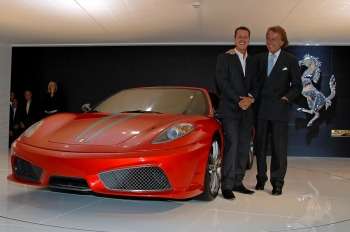|
| ||||||||||||||||||||||||||||||||||||||||||||||||||||||||||||||||||||||||||||||||||
|
Ferrari 430 Scuderia Revealed At Frankfurt Motor Show
18th September, 2007 | |||||||||||||||||||||||||||||||||||||||||||||||||||||||||||||||||||||||||||||||||
|
Ferrari has taken the wraps of the Ferrari 430 Scuderia at the Frankfurt Motor Show (IAA). The 430 Scuderia is based on the F430 and developed specifically with Ferrari’s most demanding, aggressive and passionate customers in mind. The new two-seater berlinetta is brimming with technology and joins the F430 and F430 Spider to complete Ferrari’s eight-cylinder model range. Alongside the new 430 Scuderia, the entire range lined-up for the display in Frankfurt, including the F430 and the F430 Spider, Ferrari’s best selling models (accounting for approximately 75% of sales), the 599 GTB Fiorano and the 612 Scaglietti, Ferrari’s flagship model featuring updated cabin trim and accessories, including Bose telematic system. The Frankfurt Show has also been chosen as the launch pad for several classic Ferrari colours and heritage-inspired interior trims: the F430 Spider on display features an ivory livery with chocolate brown Frau leather cabin trim, while the 599 GTB Fiorano sports a dark grey paintwork popular in the 1960s combined with a leather interior trim. The entire range of 10 historic colours together with the 16 contemporary shades is available for all models. Ferrari’s production output will exceed 6,000 cars for the first time in 2007. North America, Germany, Italy and the UK continue to be the company's largest markets together with France, Switzerland and Japan. FERRARI 430 SCUDERIA – MAIN SPECIFICATIONS AND CHARACTERISTICS
Lightweight, simple and striking with a distinctive engine and exhaust sound: every last detail of the Ferrari 430 Scuderia exudes sportiness as a direct result of its close links to the world of racing, which is reflected in the car’s name: “Scuderia”. With a dry weight of 1,250 kg and 510 hp delivered at 8,500 rpm by its naturally aspirated 4,308 cc V8 engine, the 430 Scuderia boasts a low weight-power ratio of just 2.45 kg/hp, which allows it to sprint from 0 to 100 km/h in 3.6 seconds. It can also complete a lap at Fiorano in a time comparable to that of the Enzo,. Thanks to its aerodynamics, F1-SuperFast2 gearbox and E-Diff coupled with the F1-Trac traction control system, this new mid-rear engined berlinetta combines ultra-nimble handling with fast acceleration. The result? Ferrari claim it is superlative on the road and on the track. ENGINE AND ENGINE SOUND
The inlet ducts and exhaust system have been optimised, most notably through the adoption of the exhaust geometries derived from the F430 Challenge and the use of carbon-fibre on the intake manifold and for the filter housing to aid weight reduction. The 430 Scuderia’s ignition system boasts special coils and, for the first time on a market-targeted car, a dedicated CPU capable of monitoring the ionising currents generated inside the combustion chamber between the spark plug electrodes. This means that every single sparking detonation is detected for every cylinder and sparking is faster and more accurate across the board. The 430 Scuderia’s compression ratio has also been increased to 11.88:1, thanks in part to a new piston design. Particular attention was paid to achieving the 'right' sound from the engine and exhaust as this has been one of the trademarks of every Prancing Horse car. Cutting-edge calculation tools were employed to optimise the 430 Scuderia’s intake and exhaust systems and sound damping, with the result that the exhaust and engine sound inside the cabin is clear, powerful and almost thrilling in full acceleration. F1-SUPERFAST2 GEARBOX
E-DIFF2: E-DIFF WITH F1-trAC
The 430 Scuderia is the first high performance road car after the F430 to sport an electronic differential. Torque is continuously distributed between the wheels via two sets of friction discs (one for each driveshaft) controlled by a hydraulic actuator. The amount of torque transmitted to the driven wheels depends on driving conditions and is said to bring advantages in terms of performance, direction stability, active safety and handling feedback. The F1-Trac traction control system, which is also derived from Ferrari’s F1 experience, ensures that drivers will be able to extract performance from the car, thanks to the cornering, safety and stability it offers. Introduced for the first time on a road car with the Ferrari 599 GTB Fiorano, it is faster and more precise than a traditional traction control system and optimises traction by modulating power delivery to help maintain the desired vehicle trajectory. The system estimates the maximum available grip thanks to continual monitoring of the relative speed of the wheels. The integrated E-Diff and F1-Trac systems offers 40% more acceleration out of corners than a traditional traction and stability control system. RACING MANETTINO
Another novelty with the 430 Scuderia is a button on the centre console which allows the suspension to be controlled separately from the predefined manettino strategy. This allows the driver to maintain maximum performance even on irregular road surfaces. BRAKES
The front discs are now 18 mm larger than those on the F430 and are designed to dissipate the extra heat generated by the higher performance and are even more hard-wearing for greater efficiency. These components, together with 6-pot callipers, guarantee blistering performance at all times and, equally importantly, consistently efficient braking during prolonged track use. AERODYNAMICS
The aerodynamic efficiency of the newly-styled rear diffuser has been enhanced by the addition of a revised profile for spoiler at the rear of the engine cover and by the large venturis that run from the front wheel houses to the rear bumpers, achieving the patented “Base Bleed” effect developed by Ferrari as part of the FXX project. The Base Bleed effect has the advantage of reducing the pressure in the rear wheel arch, thereby increasing downforce and lowering drag by blowing the car’s “wake”. Furthermore, the new lower sill profiles ensure a more uniform distribution of air over the lower parts to ensure uniform distribution of the vertical load between the front and the rear of the car. Vehicle dimensions
| ||||||||||||||||||||||||||||||||||||||||||||||||||||||||||||||||||||||||||||||||||
ABN 47106248033 |
 |
All rights reserved. |
